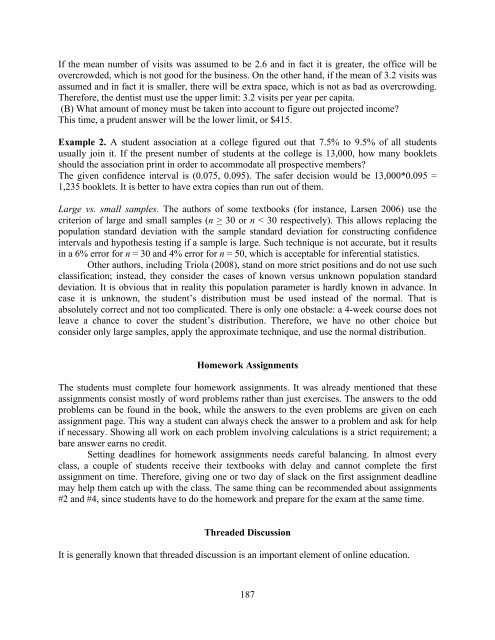Journal of Research in Innovative Teaching - National University
Journal of Research in Innovative Teaching - National University
Journal of Research in Innovative Teaching - National University
Create successful ePaper yourself
Turn your PDF publications into a flip-book with our unique Google optimized e-Paper software.
If the mean number <strong>of</strong> visits was assumed to be 2.6 and <strong>in</strong> fact it is greater, the <strong>of</strong>fice will be<br />
overcrowded, which is not good for the bus<strong>in</strong>ess. On the other hand, if the mean <strong>of</strong> 3.2 visits was<br />
assumed and <strong>in</strong> fact it is smaller, there will be extra space, which is not as bad as overcrowd<strong>in</strong>g.<br />
Therefore, the dentist must use the upper limit: 3.2 visits per year per capita.<br />
(B) What amount <strong>of</strong> money must be taken <strong>in</strong>to account to figure out projected <strong>in</strong>come<br />
This time, a prudent answer will be the lower limit, or $415.<br />
Example 2. A student association at a college figured out that 7.5% to 9.5% <strong>of</strong> all students<br />
usually jo<strong>in</strong> it. If the present number <strong>of</strong> students at the college is 13,000, how many booklets<br />
should the association pr<strong>in</strong>t <strong>in</strong> order to accommodate all prospective members<br />
The given confidence <strong>in</strong>terval is (0.075, 0.095). The safer decision would be 13,000*0.095 =<br />
1,235 booklets. It is better to have extra copies than run out <strong>of</strong> them.<br />
Large vs. small samples. The authors <strong>of</strong> some textbooks (for <strong>in</strong>stance, Larsen 2006) use the<br />
criterion <strong>of</strong> large and small samples (n > 30 or n < 30 respectively). This allows replac<strong>in</strong>g the<br />
population standard deviation with the sample standard deviation for construct<strong>in</strong>g confidence<br />
<strong>in</strong>tervals and hypothesis test<strong>in</strong>g if a sample is large. Such technique is not accurate, but it results<br />
<strong>in</strong> a 6% error for n = 30 and 4% error for n = 50, which is acceptable for <strong>in</strong>ferential statistics.<br />
Other authors, <strong>in</strong>clud<strong>in</strong>g Triola (2008), stand on more strict positions and do not use such<br />
classification; <strong>in</strong>stead, they consider the cases <strong>of</strong> known versus unknown population standard<br />
deviation. It is obvious that <strong>in</strong> reality this population parameter is hardly known <strong>in</strong> advance. In<br />
case it is unknown, the student’s distribution must be used <strong>in</strong>stead <strong>of</strong> the normal. That is<br />
absolutely correct and not too complicated. There is only one obstacle: a 4-week course does not<br />
leave a chance to cover the student’s distribution. Therefore, we have no other choice but<br />
consider only large samples, apply the approximate technique, and use the normal distribution.<br />
Homework Assignments<br />
The students must complete four homework assignments. It was already mentioned that these<br />
assignments consist mostly <strong>of</strong> word problems rather than just exercises. The answers to the odd<br />
problems can be found <strong>in</strong> the book, while the answers to the even problems are given on each<br />
assignment page. This way a student can always check the answer to a problem and ask for help<br />
if necessary. Show<strong>in</strong>g all work on each problem <strong>in</strong>volv<strong>in</strong>g calculations is a strict requirement; a<br />
bare answer earns no credit.<br />
Sett<strong>in</strong>g deadl<strong>in</strong>es for homework assignments needs careful balanc<strong>in</strong>g. In almost every<br />
class, a couple <strong>of</strong> students receive their textbooks with delay and cannot complete the first<br />
assignment on time. Therefore, giv<strong>in</strong>g one or two day <strong>of</strong> slack on the first assignment deadl<strong>in</strong>e<br />
may help them catch up with the class. The same th<strong>in</strong>g can be recommended about assignments<br />
#2 and #4, s<strong>in</strong>ce students have to do the homework and prepare for the exam at the same time.<br />
Threaded Discussion<br />
It is generally known that threaded discussion is an important element <strong>of</strong> onl<strong>in</strong>e education.<br />
187

















